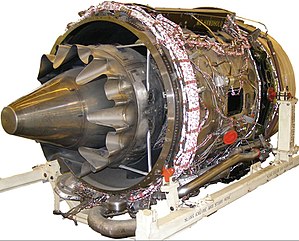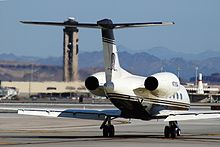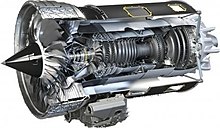avia.wikisort.org - Engine
The Rolls-Royce BR700 family of turbofan engines powers regional jets and corporate jets. It was developed by BMW and Rolls-Royce plc through the joint venture BMW Rolls-Royce AeroEngines GmbH, established in 1990. The BR710 first ran in 1995.[1] It is manufactured in Dahlewitz, Germany. Rolls-Royce took full control of the company in 2000, which is now known as Rolls-Royce Deutschland. The military designation of the series is F130.[3]
| BR700 series | |
|---|---|
 | |
| Rear view of a BR710 | |
| Type | Turbofan |
| Manufacturer | BMW Rolls-Royce Rolls-Royce Deutschland |
| First run | 1995[1] |
| Major applications | Bombardier Global Express Boeing 717 Gulfstream V |
| Number built | 3,600+[2] |
Design and development
BR710

The BR710 is a twin shaft turbofan, and entered service on the Gulfstream V in 1997 and the Bombardier Global Express in 1998. This version has also been selected to power the Gulfstream G550.
The BR710 comprises a 48 in (120 cm) diameter single-stage fan, driven by a two-stage LP turbine, supercharging a ten-stage HP compressor (scaled from the V2500 unit) and driven by a two-stage, air-cooled, HP turbine.
This engine has a thrust-specific fuel consumption (TSFC) of 0.39 lb/(lbf⋅h) (11 g/(kN⋅s)) at static sea level takeoff and 0.64 lb/(lbf⋅h) (18 g/(kN⋅s)) at a cruise speed of Mach 0.8 and altitude of 35,000 ft (10,668 m).[4]
In May 2017, the 3,200 engines in service reached 10 million flying hours.[1]
Another rerated version, with a revised exhaust system, was selected for the now-cancelled Royal Air Force Nimrod MRA4s.
BR715

The BR715 is another twin-shaft turbofan; this engine was first run in April 1997 and entered service in mid-1999. This version powers the Boeing 717.
A new LP spool, comprising a 58 in (150 cm) diameter single-stage fan, with two-stage LP compressor driven by a three-stage LP turbine, is incorporated into the BR715. The HP spool is similar to that of the BR710.
The IP compressor booster stages supercharge the core, increasing core power and thereby net thrust. However, a larger fan is required, to keep the specific thrust low enough to satisfy jet noise considerations.
This engine has a TSFC of 0.37 lb/(lbf⋅h) (10 g/(kN⋅s)) at static sea level takeoff and 0.62 lb/(lbf⋅h) (18 g/(kN⋅s)) at a cruise speed of Mach 0.8 and altitude of 35,000 ft (10,668 m).[4]: 96
BR725

The BR725 is a variant of the BR710 to power the Gulfstream G650.[5] Its prototype underwent component bench and its first full engine run in spring 2008.[6] European certification was achieved in June 2009.[7] The first Gulfstream G650, with BR725 engines, was delivered in December 2011.[8]
The engine has a maximum thrust of 75.2 kN (16,900 lbf).[9] The 50 in (130 cm) fan with 24 swept blades is 2 in (5.1 cm) larger than the BR710. The HP axial compressor benefits from three-dimensional aerodynamics for greater efficiency and has 10 stages including five blisks to reduce weight. The BR715 inspired combustor yields a longer life and lower emissions: 80% lower smoke and unburned hydrocarbons and 35% lower NOx than CAEP 6 limits. The two-stage HP turbine has blade active tip-clearance control for more efficiency; 3D aerodynamics reduce the cooling air flow. The LP turbine has three stages instead of two. The BR725 has a bypass ratio of 4.2:1 and is 4 dB quieter than the predecessor BR710. Its cruise thrust specific fuel consumption at Mach 0.85 and FL450 is 0.657 lb/lbf/h (18.6 g/kN/s).[10]
Rolls-Royce offered the BR725 (F130 in the US military) with 75.6 kN (17,000 lbf) for the United States Air Force’s (USAF) B-52H Stratofortress Commercial Engine Replacement Program (CERP).[11] On 24 September 2021 the USAF selected the F130, rejecting proposals from GE Aviation and Pratt & Whitney. The USAF intends to purchase 650 engines (608 direct replacements, 42 spare engines) for its fleet of 76 B-52H aircraft in a $2.6 billion deal.[12] The CERP engines will be built at Rolls-Royce North America's Indianapolis, Indiana, plant.[13]
Future developments
The Advance 2 development effort inserts new, advanced technology into existing 67 kN (15,000 lbf) class BR710 and the larger BR725 engines. An even larger engine will also be made, with a 52 in (130 cm) fan. The BR710 and BR715 main developments, the next generation of 44–89 kN (10,000–20,000 lbf) engines to be introduced in the 2020s, will have an Advance 3 core, improved engine health management, newer materials, and cooling. They will also have a “blisk” fan made out of titanium, with an overall pressure ratio of 50:1. These improvements will yield a 10% thrust specific fuel consumption reduction, 50% NOx margin improvement, 99.995% reliability, and a 20% better thrust-to-weight ratio.[14]
Pearl 15

The Pearl engine was developed in Dahlewitz from the BR700 with Advance2 technologies.[15] EASA certification was applied for on 28 February 2015.[9] It made its first ground run in 2015, type tests in 2016, and flight tests in 2017.[16] Six test engines logged over 6,000 cycles on 2,000 test hours.[17] The test program included lightning strike, water ingestion, ice, and -40 °C cold-start testing.[18]
EASA certification was granted on 28 February 2018 and it was unveiled on 28 May 2018. It was undergoing flight tests in May 2018 for an end of 2019 planned entry into service aboard the Bombardier Global Express 5500 and 6500 developments.[15] It should have logged 10,000 hours by then.[18]
Its layout is similar to the BR725, with the same stage count and 24 titanium fan blades.[17] Its fan has a 48.5 in (123 cm) diameter.[19] The enhanced 3-stage LP turbine with advanced high temperature materials, advanced segments and seals allow for higher pressures and temperatures and the new low emissions cooled combustor includes a new tiled combustion chamber.[16] Its core uses advanced nickel alloys and ceramic coatings, includes a new 10-stage HP compressor with 6 titanium blisks and a new 2-stage HP turbine with enhanced aerodynamics and blade cooling, enhanced segments and seals.[16]
Its overall pressure ratio attains 43:1 and its bypass ratio 4.8:1.[16] The HP compressor ratio rises to 24:1.[17] It delivers up to 9% more thrust with 15,125 lbf (67.28 kN) and a 7% TSFC improvement while being 2 decibels quieter.[15] Health monitoring should improve on the BR710 99.97% dispatch reliability which is logging one unplanned engine removal per 100,000 hours while the BR715 is approaching zero unplanned removals.[19]
Pearl 700
The Pearl 700 will power the Gulfstream G700, a stretch of the previous G650. Evolved from the BR725 with a similar architecture plus a fourth low-pressure turbine stage and a 2 in (5.1 cm) larger, 51.8 in (132 cm) blisk fan, its bypass ratio is higher than 6.5:1 and its overall pressure ratio should exceed 50:1. It should provide 18,250 lbf (81.2 kN) of thrust, 3-5% better thrust specific fuel consumption than the BR725 variant powering the Gulfstream G650, reduced emissions and lower noise.[20]
Pearl 10X
The upcoming Dassault Falcon 10X will be powered by two Pearl 10X engines over 18,000 lbf-thrust (80 kN), with a titanium fan blisk, a 10-stage HP compressor, a two-stage shroudless HP turbine and a four-stage LP turbine.[21] The initial Pearl 10X test engine was first run in early 2022 and the programme had accumulated 1,000h of testing by May, along with the Advance2 demonstrator.[22] The Advance2 core and new low-pressure system allows 5% more efficiency than the previous Rolls-Royce business jet engines.[22]
Variants
- BR700-710A1-10
- Variant with a 65.6 kN (14,700 lbf) takeoff rating and a maximum diameter of 1820mm for the Gulfstream GV.[23]
- BR700-710A2-20
- Variant with a 65.6 kN (14,700 lbf) takeoff rating and a maximum diameter of 1820mm for the Bombardier Global Express/XRS/5000/6000.[23]
- BR700-710B3-40
- Variant with a 69 kN (16,000 lbf) takeoff rating for the BAE Systems Nimrod MRA4.[24]
- BR700-710C4-11
- Variant with a 68.4 kN (15,400 lbf) takeoff rating and a maximum diameter of 1785mm for the Gulfstream GV-SP (G500/G550).[23]
- BR700-710D5-21
- Variant with a 67.8 kN (15,200 lbf) takeoff rating and a maximum radius of 980mm for the Bombardier Global 5500/6500.[23]
- BR700-715A1-30
- Variant with a 83.23 kN (18,710 lbf) takeoff rating for Boeing 717-200 basic gross weight variants.[25]
- BR700-715B1-30
- Variant with an 89.68 kN (20,160 lbf) takeoff rating.[25]
- BR700-715C1-30
- Variant with a 95.33 kN (21,430 lbf) takeoff rating for Boeing 717-200 high gross weight variants.[25]
- BR700-725A1-12
- Variant with a 75.2 kN (16,900 lbf) takeoff rating and a maximum radius of 950 mm for the Gulfstream GVI (G650).[23]
- BR700-TP
- Turboprop variant rated at 7,460 kilowatts (10,000 shaft horsepower) and targeted for the European Future Large Aircraft (eventual Airbus A400M Atlas military transporter/tanker).[26]
The BR715 thrust ratings can be adjusted by changing a plug in the FADEC controller, meaning no engine change is required. The A1-30 can become a C1-30 with a simple plug and software change.
Applications
- BAE Systems Nimrod MRA4
- Bombardier Global Express
- Boeing 717
- Boeing B-52H Stratofortress (F130 variant)
- Dassault Falcon 10X
- Gulfstream V
- Gulfstream G550
- Gulfstream G650/G700
- Rekkof/Fokker XF70/XF100[27]
- Tupolev Tu-334
Specifications
| Model | BR700-710A1/A2/C4 | BR700-715[28] | BR700-725A1 | BR700-710D5-21 (Pearl 15) |
Pearl 700[20] |
|---|---|---|---|---|---|
| Compressor | 1 fan, 10 HPC | 1 fan, 2 LPC, 10 HPC | 1 fan, 10 HPC | ||
| Turbine | 2 HPT, 2 LPT | 2 HPT, 3 LPT | 2 HPT, 4 LPT | ||
| Thrust | 68.4 kN (15,400 lbf) | 95.33 kN (21,430 lbf) | 75.2 kN (16,900 lbf) | 67.8 kN (15,200 lbf) | 81.2 kN (18,250 lbf) |
| Dry Weight | 1,818.4 kg (4,009 lb) | 2,085 kg (4,597 lb) | 1,635.2 kg (3,605 lb) | 1,828.8 kg (4,032 lb) | |
| Thrust / Weight | 3.84 | 4.66 | 4.69 | 3.77 | |
| Length | 4,669 mm (183.8 in) | 3,738 mm (147.2 in) | 3,297 mm (129.8 in) | 4,809 mm (189.3 in) | |
| Rotor RPM | LP: 6,096, HP: 16,661 | LP: 6,096, HP: 16,661 | LP: 6,096, HP: 16,661 | LP: 7,431, HP: 19,000 | |
| Fan Diameter | 48 in (122 cm)[10] | 58 in (147 cm)[29] | 50 in (127 cm)[10] | 48.5 in (123 cm)[19] | 51.8 in (132 cm) |
| Bypass ratio[30] | 3.84:1 | 4.55–4.68:1[31] | 4.1:1 | 4.8:1[16] | >6.5:1 |
| Overall pressure ratio | 43:1[16] | >50:1 | |||
See also
Comparable engines
- General Electric CF34
- General Electric Passport
- IAE V2500
- PowerJet SaM146
- Pratt & Whitney PW6000
- Pratt & Whitney Canada PW800
- Progress D-436
Related lists
References
- "Rolls-Royce achieves 10 million flying hours on its BR710 engine" (Press release). Rolls-Royce. 22 May 2017.
- "BR710". Rolls-Royce. Retrieved 21 September 2020.
- Rolls Royce offers BR725 for B-52 re-engine effort
- Élodie Roux (2007). Turbofan and turbojet engines: Database handbook. p. 94. ISBN 9782952938013. OCLC 879328119.
- "Gulfstream G650 - Rolls-Royce power". FlightGlobal. 13 March 2008.
- "Rolls-Royce completes successful first run of BR725 engine". FlightGlobal. 30 Apr 2008.
- "Rolls-Royce wins certification for BR725 engine". FlightGlobal. 25 Jun 2009.
- "Gulfstream completes first G650 delivery, gains production authority". FlightGlobal. 28 Dec 2012.
- "Type Certificate Data Sheet E.018". EASA. 28 February 2018.
- Thierry Dubois (April 28, 2010). "Engine makers consider clean-sheet designs". Aviation International News.
- "Rolls Royce offers BR725 for B-52 re-engine effort". FlightGlobal. 14 September 2017. Retrieved 17 September 2017.
- "DAF awards Rolls-Royce B-52H engine contracte". Department of the Air Force. 24 Sep 2021.
- Tirpak, John (September 24, 2021). "Rolls-Royce Wins B-52 Re-Engining Program Worth $2.6 Billion". Air Force Magazine. Air Force Association. Retrieved September 25, 2021.
- "Rolls-Royce Bullish On Prospects For Bizjet Sector". Aviation International News. April 11, 2017.
- "Rolls-Royce celebrates launch of new Pearl engine family" (Press release). Rolls-Royce. 28 May 2018.
- "Pearl 15". Rolls-Royce.
- Stephen Trimble (28 May 2018). "Rolls-Royce reveals surprise Pearl engine family for business jets". Flightglobal.
- Kerry Lynch (May 28, 2018). "Rolls-Royce Pearl 15 Marks Launch of New Engine Family". AIN online.
- John Morris (May 28, 2018). "Rolls-Royce Barrels Back Into Bizjets With Pearl Engine". Aviation Week Network.
- Fred George (Oct 21, 2019). "Gulfstream Unveils New G700 Flagship At NBAA-BACE". Aviation Week Network.
- Dominic Perry (6 May 2021). "Dassault takes fight to ultra-long-range rivals with Falcon 10X launch". Flightglobal.
- Dominic Perry (22 May 2022). "Pearl 10X engine testing spools up". Flightglobal.
- "EASA.E.018". EASA. European Aviation Safety Agency. 23 June 2009. Retrieved 2020-08-05.
{{cite web}}: CS1 maint: url-status (link) - "BR710". Rolls-Royce Germany. Retrieved 3 January 2010.
- "Type Certificate Data Sheet E.023 - BR700-715 series engines" (PDF). European Aviation Safety Agency. 27 July 2009. Archived from the original (PDF) on 23 December 2009. Retrieved 3 January 2010.
- "BMW Rolls-Royce presents prop BR700". Flight International. 4 March 1997.
- "Fokker to re-join the battle for the 100-seat market with XF100 NG - FlightBlogger - Aviation News, Commentary and Analysis". www.flightglobal.com. Archived from the original on 2010-03-11.
- "Type Certificate Data Sheet E.023" (PDF). EASA. 27 July 2009.
- "BR715". Rolls-Royce.
- John Croft (29 Sep 2008). "G650: As good as it gets?". Flightglobal.
- "BR715: Power for the Boeing 717-200" (PDF). Rolls-Royce. May 2005. Archived from the original (PDF) on 19 October 2006. Retrieved 3 October 2020.
External links
- BR700: Technical data
- BR710: Power for ultra-long range business jets and special mission aircraft
- Guy Norris (2 June 1999). "European powerhouse". Flight International.
| This aircraft engine article is missing some (or all) of its specifications. If you have a source, you can help Wikipedia by adding them. |
На других языках
[de] Rolls-Royce BR700
Unter der Bezeichnung BR700 versteht man eine Reihe von Mantelstromtriebwerken, die von Rolls-Royce Deutschland gebaut werden. Die BR-Triebwerke sind Zweiwellentriebwerke der mittleren Schubklasse und für Geschäftsreise- und kleinere Linienflugzeuge vorgesehen. Sie zeichnen sich besonders durch ihre geringe Geräusch- und Schadstoffemission sowie einen niedrigen Verbrauch aus.- [en] Rolls-Royce BR700
[es] Rolls-Royce BR700
La familia de motores BR700 fue desarrollada por BMW y Rolls-Royce plc a través de la unión de empresas BMW Rolls-Royce para motorizar aviones regionales y ejecutivos. Rolls-Royce tomó el control de toda la empresa en 2000 que es ahora conocida como Rolls-Royce Deutschland.[fr] Rolls-Royce BR700
Les réacteurs Rolls-Royce BR700 font partie de la gamme moyenne puissance des réacteurs développés par BMW et Rolls-Royce plc à travers la coentreprise BMW Rolls-Royce et commercialisés par le motoriste britannique Rolls-Royce.[it] Rolls-Royce BR700
La serie Rolls-Royce BR700 è una famiglia di motori aeronautici turboventola sviluppati da Rolls-Royce e BMW.[ru] Rolls-Royce BR700
Rolls-Royce BR700 — семейство авиационных двигателей разработанных BMW и Rolls-Royce plc через совместное предприятие BMW Rolls-Royce, предназначенных для региональных и корпоративных самолётов. Rolls-Royce взяла полный контроль над компанией в 2000 году, который сейчас известен как Rolls-Royce Deutschland. Компания была основана в 1990 году и первый запуск двигателя (BR710) состоялся в сентябре 1994 года. Производится в Далевице, Германия.Другой контент может иметь иную лицензию. Перед использованием материалов сайта WikiSort.org внимательно изучите правила лицензирования конкретных элементов наполнения сайта.
WikiSort.org - проект по пересортировке и дополнению контента Википедии